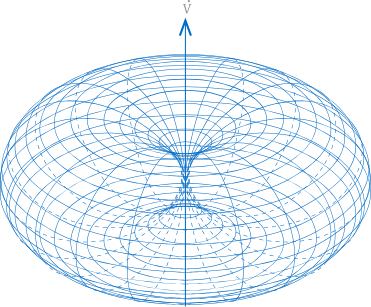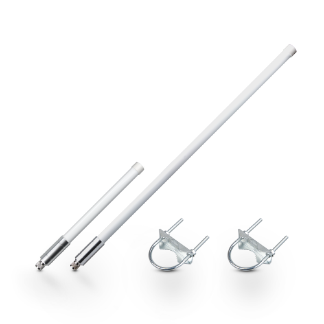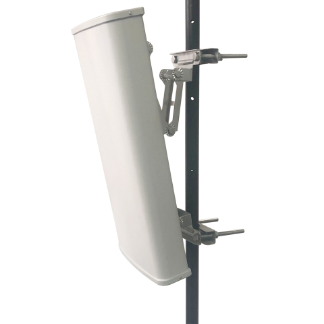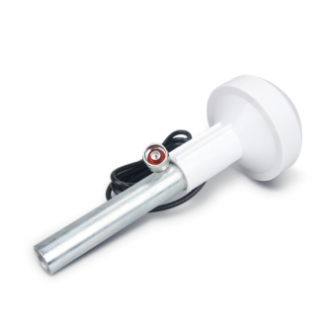Introduction
Antennas are an integral part of any Radio Frequency (RF) communication system. By definition an antenna is a transducer, a device used to transform RF signals traveling on a conductor (wire, waveguide for example) into an electromagnetic wave in free space and vice versa (this is due to the fact they are reciprocal devices, retaining the same characteristics regardless if they are transmitting or receiving).
As antennas are resonant devices, they can only operate efficiently in a certain frequency bandwidth, for a certain central frequency (frequencies), which is called tuning.
In order for a system to work the frequency the antenna is tuned to must be the same the rest of the system is operating at, in order to receive/transmit adequately. This relates to antenna matching.
Last but not least, an antenna emits the radiation it converts in a certain in space in a certain way (shape), which has a graphical representation called radiation pattern.

Figure 1: Antennas and their place in RF systems
Antenna basics
Before delving into detail into what types of antenna there are and what their performance is we need to explain a number of terms that pertain to antenna characteristics. This will allow us to efficiently describe antenna performance and compare different types.
 Input impedence
Input impedence
In order to have efficient transfer of energy (power) between the antenna, cable (when applicable) and radio device, they need to have the same impedance. Typically transceivers (radio devices) are designed with 50 Ohm impedance (also the case for LoRa/LoRaWAN), thus the antenna must also have impedance of 50 Ohm. If the aforementioned is not the case there will be the need for a matching circuit, otherwise the mismatch will cause reflection of the signal (energy) and will result in losses (decreased efficiency).
 VSWR
VSWR
Another way to express the return loss (more commonly used parameter) is to use the variations of the voltage along the transmission line (highest to lowest ratio). The relationship between VSWR and Return loss is:

 Directivity
Directivity
Antennas are mean to transfer the signal between the receiver and transmitter, thus they need to be able to focus the energy in a particular and also receive better from a particular direction. This would make it possible for an antenna to transfer the energy more efficiently especially if the two devices are static with respect to each other.
In cases where the positions change, it is generally not optimal to have an antenna with high directivity, as the direction where one would want to transmit optimally changes with the position of the transmitter/receiver. In such situation antennas that radiate equally in all directions are best, which are called omni-direction (omni) antennas.
 Far field conditions
Far field conditions
Antennas are mean to transfer the signal between the receiver and transmitter, thus they need to be able to focus the energy in a particular and also receive better from a particular direction. This would make it possible for an antenna to transfer the energy more efficiently especially if the two devices are static with respect to each other.
In cases where the positions change, it is generally not optimal to have an antenna with high directivity, as the direction where one would want to transmit optimally changes with the position of the transmitter/receiver. In such situation antennas that radiate equally in all directions are best, which are called omni-direction (omni) antennas.

 Radiation pattern
Radiation pattern
The radiation (antenna pattern) represents the way the antenna radiates in various directions at a constant distance (this is normally in the far field area), this is also the reception pattern since it also relates to the receiving properties of the antenna.
The radiation pattern is three-dimensional, however it is most commonly represented in a two-dimensional slice of the pattern in the horizontal or vertical plane. Most commonly the two-dimensional patterns are presented in polar coordinate format, as it is easier to visualize.
Let us look at an example dipole antenna pattern shown in its three-dimensional variant in Figure 4:

Figure 4: 3D radiation of a dipole antenna
.png?s=decfe07e54f2d91609e60a581dc82a62)
Figure 5: 2D radiation of a dipole antenna
 Sidelobes
Sidelobes
Antennas are not perfect, so they can't radiate all the energy only in the direction of the main lobe. The energy peaks that are not in the main lobe direction are called side lobes. They are commonly specified in dB down from the main lobe.
 Polarization
Polarization
In short this is the orientation of the electric field of the electromagnetic wave (energy) that is radiated/received by the antenna. Without going into details we will mention there are 3 types of polarization in general: vertical, horizontal, circular (right-handed, left-handed). As an example omnidirectional antennas are vertically polarized, always.
 Return Loss
Return Loss
This relates to impedance matching, as it is a way of quantifying the resulting energy loss. It is expressed in logarithmic ratio (measured in dB) and is the value of the ration of the power reflected by the antenna (due to impedance mismatch) to the total power fed to the antenna via the transmission line (cable).

 Bandwidth
Bandwidth
The bandwidth of an antenna refers to the range of frequencies over which the antenna can operate correctly. As a rule of thumb the bandwidth is considered to be the frequency area for which the antenna VSWR is less than 2:1.
Different antennas have different bandwidths.
 Gain
Gain
As gain is not a quantity that can be defined in absolute terms it is a dimensionless ratio, which is given in reference to a standard antenna (expressing how much better the performance is compared to the standard antenna).
The two most common antennas used as reference when talking about gain are:
Isotropic antenna
This type of antenna radiates equally in all directions. This is a purely theoretical construct, such antenna does not exist in practice, however it is very useful when used as reference for real antennas. A real antenna of any type will radiate more energy in a certain directions and less in others. Since an antenna is a passive device it can not create energy, thus its total radiated power is the same as of an isotropic antenna.
So, the gain of the antenna in a given direction is the amount of energy radiated in this direction as compared to an isotropic antenna, given that both antennas have the same signal source. The maximum gain (most interesting parameter) is the gain in the direction where the antenna radiates the most power.
This gain is expressed in dBi (dB compared to an i-sotropic antenna). For example 3dBi gain means that that the gain is 3dB compared to an isotropic antenna (twice as much in linear scale).
Dipole antenna
The other antenna used for standard comparison is the half-wave dipole. This comparison in gain is expressed in dBd (dB compared to a d-ipole antenna). An antenna gain of 3dBd means that the antenna has 3dB gain more compared to a dipole antenna.'
 Free space propagation
Free space propagation
In order to have this condition met, there must be a direct line of sight between the two antennas, meaning there must be no obstacle in-between the two. In addition, it is recommended for the first Fresnel zone to be free of obstacles (in order to avoid negative effects due to superposition of direct and reflected signals). We would not go into detail on how to calculate Fresnel clearance, however for the purposes of gaining basic understanding one could look at Figure 3 in order to visualize approximately how big the first Fresnel zone is:

Figure 3: First Fresnel zone
 Beamwidth
Beamwidth
The term antenna beamwidth usually means the half-power beamwidth. In order to determine this parameter one would need to know the peak radiation intensity (highest gain point) and take the points on its side where its level drops to half the value. The angular distance between these two points is defined as the beamwidth.
 Nulls
Nulls
This is a spot in the antenna radiation pattern that falls between two lobes and the affective radiated power at this point is minimal. These nulls are useful as reception in their direction is minimal and they can be used to suppress interfering signal coming from a given direction.
 Polarization mismatch
Polarization mismatch
As was the case with Impedance, in order to have a maximum power transfer between two antennas they must have the same polarization. When their polarization is not the same the will be a reduction in the transferred power between the two. Thus, make sure both antennas have the same polarization and their spatial orientation is the same in order to ensure optimal transmission/reception.
Type of Antennas
Let us classify antennas based on one of the following: frequency/size, directivity, physical traits, and application.
Frequency / size
Antennas are tuned to different frequencies as different RF systems operate in different parts of the Spectrum. The wavelength being different for different frequencies means antennas will also differ in size as it is related to the wavelength they need to operate at.
For example, all things being equal, a 900MHz antenna for LoRaWAN will have a wavelength of 33cm, where as a 2100MHz antenna for cellular will have a wavelength of 14cm, which is more than 2 times smaller.
Directivity
As mentioned before the antenna could be omnidirectional, radiating equally in all directions (Dipole, Ground plane).
Another option is the sectorial antenna (mainly used in cellular) that radiates primarily in an area, where the beam width can be 60 or 180 degrees for example.
Directional antennas are also widely used (Radio relays) as they have a very narrow beam width (smaller than 30 degrees usually), which results in a large gain and improved range. An example would be the Yagi antenna, the horn antenna, the patch antenna, the parabolic dish antenna, etc.
Physical traits
There are differnet constructions, we will not go into details, however some notable ones are patch antennas made via PCB substrate in the for of metallic circuitry. The monopole which is basically a wire, there are also flexible antennas built on ceramics.
Based on their construction some antennas can be outdoor capable and some indoor only.
Application
It is most common in RF systems (which IoT and LoRaWAN fall within too) to have one of two applications: Base station, Point-to-point.
The first type is for broadcasting/wide area reception and is usually an outdoor capable omnidirectional antenna, or a combination of several sectorial antennas.
The point-to-point antennas are usually directive as they connect two devices that are for most cases very far apart, stationary and require a lot of gain to establish the link.
RAK Antenna Comparison
Below are listed the antenna type RAKwireless offers. They include a short description explaining their main feature. For detailed comparison between particular models and recommendations on deployment scenarios and best practices refer to the second article in this series.
Dipole antennas
Dipole antennas
This can be considered as the most widely used and fundamental antenna. It has the possibility of having 50Ohm input impedance, making it easy to connect to to common cables.
Its radiation pattern has already been shown in Figure 4 in 3D and in Figure 5 in its 2D representation. There are different type of dipoles depending on the portion of the wavelength it has the length of (Quarter, Half, etc.). This article will look into the Half-wave Dipole in particular. While this antenna can be used as a broadband one it generally is not as it suffers from a number of problems: input impedance mismatching (away from the half-wavelength frequency), changes in radiation pattern with the increase of the length/wavelength ratio.
One notable advantage is that it requires no ground plane.
Figure 6: Dipole radiation pattern with reference to length/wavelength ratio
Thus this antenna is most commonly used as a half-wave dipole, tuned around a single center frequency. One thing to note is because of its symmetric construction a balun is required when connecting it with an unbalanced cable (coaxial).
What RAK offers in particular
All RAK fiberglass antennas, all gateway stock antennas. An example is shown below:

Fiber Glass Antenna Visit Store >
Sectoral antennas
Sectoral antennas
As we have mentioned, true isotropic antennas do not exist, however there are many antennas that can be considered omnidirectional in at least one plane (Dipole for example). For an antenna to be considered directional it has to focus its radiated power in a specific radiated direction. This results in a significant gain, however also in a narrower beamwidth, leading to the disadvantage of a smaller coverage area and the need to properly aim/align the antenna.
Nowadays the most widespread design for directional antennas is the antenna array. Simply put one uses several antenna elements (fundamental antenna types) that are fed signals with different phase, resulting into a super-positioned radiated power distribution with significantly narrower beam.
The sectorial antenna is a special type of directional antenna with a sector-shaped radiation pattern. Sector in the sense used here means simply that the geometrical shape of the diagram represents a sector of the full 360 degree circle. These antenna can be 60, 90 or 120 degrees. They are commonly used in cellular system where several are deployed in sectors to cover the full 360 coverage range of a Base station. This allows for frequency partitioning of the sectors.
Such antennas are most of the time antenna arrays as this allows for a more compact construction, better gain and directivity and also electrically steering the beam direction (tilt of the antenna).
What RAK offers in particular

12dBi Directional Antenna
Visit Store >
Patch antennas
Patch antennas
These are really low profile antennas designed for surface mounting. It consists of a of a substrate (FR4 for example), used as a base that has a metallic patch (rectangle, square, etc.) on top, and is completely covered with metal on the bottom (ground plane). The two metal pieces for a resonant transmission line with approximately half-wavelength in physical length. This is mostly used in microwave frequencies.
Additionally it is very easy to use multiple patches on the same substrate to make an antenna array.
What RAK offers in particular
The LoRa PCB antennas we offer for the LoRa modules together with the GPS antennas (both active and passive) are patches.

GPS Antenna 27dBi Visit Store >
Active antennas
Active antennas
In this article an active antenna is one that has an active element, a pre-amplifier that boosts the received signal and is integrated in the antenna base. These antennas can be a lot smaller as the amplifier compensate for the loss of performance, which allows the to fit in applications that would normally require much larger antennas for the frequencies the system operates at. One disadvantage is that the coaxial cable used to carry the signal (usually) has to also carry the DC to power the amplifier circuitry.
What RAK offers in particular
The RAK External GPS antennas are all Active antennas. An example is shown below:

GPS Antenna Visit Store >